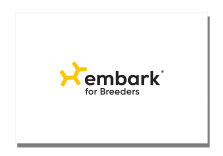Progressive Retinal Atrophy 5, PRA5
Progressive retinal atrophy (PRA) describes a group of non-painful inherited disorders of the retina's photoreceptor cells that result in vision loss in dogs. PRA caused by this NECAP1 variant is a late-onset (later in life) form of PRA, affecting dogs whose eyes have completed their normal development.
-
Signs and symptoms
A dog with decreased vision may be reluctant to walk down stairs, enter a dark room, or go outside at night. They may bump into door frames or corners and have difficulty fetching toys. You may notice a characteristic eyeshine due to increased reflectivity of the tapetum, the layer of the eye that reflects light. The dog's discernible visual impairment will typically lag behind changes observed by a veterinarian and electroretinogram (ERG) abnormalities.
This form of PRA is typically diagnosed at around four years old. -
Diagnosis
PRA is diagnosed by examination of the back of the eye (the fundus). In the early stages, observing changes to the retina may be difficult. Still, as the disease progresses, a veterinarian will notice increased reflectivity and thinning of the retinal blood vessels. Changes affect both eyes equally, helping to distinguish PRA from other retinal diseases. A veterinary ophthalmologist can perform an ERG, which measures the electrical activity, and thus the function, of the retinas.
-
Treatment
Currently, there is no widespread treatment for progressive retinal atrophy. However, gene therapy is an evolving field.
-
What to do if your dog is at risk
Actions
- Talk to your vet about your dog’s PRA result so you can work together to plan their ongoing care and monitoring.
- Schedule regular eye exams with your vet or a veterinary ophthalmologist to monitor for changes or complications such as cataracts.
- If your dog’s vision changes, help them adjust by keeping furniture and routines consistent, using verbal cues, and keeping them on a leash in unfamiliar areas.
- Products such as protective halos can also help dogs navigate safely if their vision declines.
-
Genetic Information
This variant was first described in the Giant Schnauzer.
This variant is inherited in an autosomal recessive manner, meaning a dog requires two copies of the variant to show signs of PRA5.
Gene names:
NECAP1 Exon 6 ‐ chr
Inheritance type:
recessive
Citations:
-
Breeds affected
This health condition affects the following breeds
Learn about your dog’s unique genetic health
Dog owners
Breed identification, health and trait insights, personalized care recommendations, and the world’s first canine relative finder—all in one leading dog DNA test.
Learn about the report for dog ownersShop the test
Breeding programs
Embark’s test for breeding programs is one comprehensive DNA test designed with your needs in mind.
Learn about the report for breedersShop the test
















